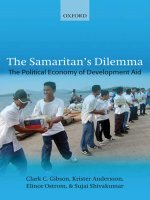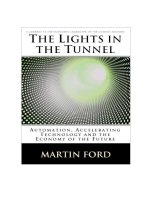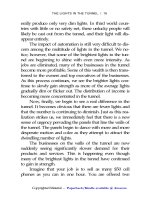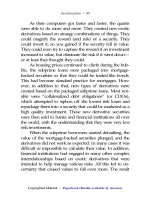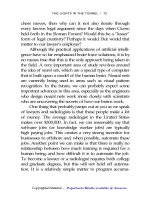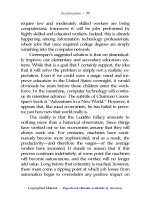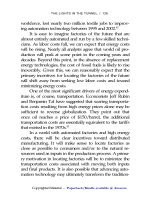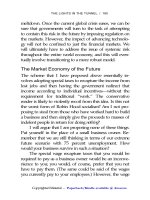The economy of bangladesh a quarter century of development
Bạn đang xem bản rút gọn của tài liệu. Xem và tải ngay bản đầy đủ của tài liệu tại đây (2.73 MB, 224 trang )
The Economy of Bangladesh
The Economy of
Bangladesh
A Quarter Century of Development
Azizur Rahman Khan
Professor Emeritus of Economics, University of California, Riverside, USA
© Azizur Rahman Khan 2015
All rights reserved. No reproduction, copy or transmission of this
publication may be made without written permission.
No portion of this publication may be reproduced, copied or transmitted
save with written permission or in accordance with the provisions of the
Copyright, Designs and Patents Act 1988, or under the terms of any licence
permitting limited copying issued by the Copyright Licensing Agency,
Saffron House, 6–10 Kirby Street, London EC1N 8TS.
Any person who does any unauthorized act in relation to this publication
may be liable to criminal prosecution and civil claims for damages.
The author has asserted his right to be identified as the author of this work
in accordance with the Copyright, Designs and Patents Act 1988.
First published 2015 by
PALGRAVE MACMILLAN
Palgrave Macmillan in the UK is an imprint of Macmillan Publishers Limited,
registered in England, company number 785998, of Houndmills, Basingstoke,
Hampshire RG21 6XS.
Palgrave Macmillan in the US is a division of St Martin’s Press LLC,
175 Fifth Avenue, New York, NY 110.
Palgrave Macmillan is the global academic imprint of the above companies
and has companies and representatives throughout the world.
Palgrave® and Macmillan® are registered trademarks in the United States,
the United Kingdom, Europe and other countries.
ISBN 978-1-349-57503-9
ISBN 978-1-137-54974-7 (eBook)
DOI 10.1057/9781137579747
This book is printed on paper suitable for recycling and made from fully
managed and sustained forest sources. Logging, pulping and manufacturing
processes are expected to conform to the environmental regulations of the
country of origin.
A catalogue record for this book is available from the British Library.
A catalog record for this book is available from the Library of Congress.
For
Mohua
Contents
List of Tables
x
Acknowledgments
xiii
List of Abbreviations
xiv
1 Introduction
The context
Successes and failures
An outline
1
1
3
8
2 Growth and Structural Change: An Overview
Growth and structure of output
Demographic transition
Change in the structure of employment
10
10
15
17
3 Macroeconomic Accounts: The Structure of Demand
Issues and puzzles
Rising rates of saving and investment
The external balance
Foreign capital inflow
Capital outflow
Selected macroeconomic issues concerning prices,
budget, money and banking
22
22
22
26
27
30
4 The Emerging Pattern of Structural Change
Historical experience
Structural change of the Bangladesh economy in the
historical context
Desirable direction of the emerging pattern of change
39
39
5 Agriculture: Past Success and Future Prospects
Declining importance of agriculture
Production performance
Factors behind the growth of agriculture
Institutional reform
Future direction
52
52
54
60
62
64
vii
33
44
47
viii
Contents
6 Structure, Growth and Direction of Manufacturing
Industries
The size and structure of manufacturing industries
Changing structure of manufacturing
Labor productivity, factor intensity and profitability
y
Gender distribution of employment
Labor productivity, factor intensity and profitability by
size and ownership
Cottage industries
Incentives and obstacles
67
67
70
74
77
80
82
85
7 Trade and Global Links
Trade regime and development
An evaluation of the reformed trade regime
Export-led development?
Merchandize imports
Remittances
Global links: foreign direct investment, foreign debt
and exchange rate
89
89
91
94
98
100
8 Infrastructure and Environment
Introduction
Transport
Energy
Skill development
Environment
108
108
108
112
118
122
9 Income Distribution, Poverty and Living Standard
Introduction
Measuring income
Measuring inequality and its sources
Poverty reduction
Indicators of living standard
Main findings
126
126
127
129
142
150
156
10
102
Conclusion: Credits, Constraints and Prospects
Factors behind the achievements
Failures, reasons thereof and challenges
Governance
The future
157
157
160
163
169
Annex to Chapters 2 and 3: Bangladesh National Accounts
172
Contents ix
Annex to Chapter 9
An assessment of the survey data
Some additional data on inequality and poverty estimates
177
177
183
Notes
186
Bibliography
203
Index
207
List of Tables
2.1
2.2
2.3
2.4
3.1
3.2
3.3
3.4
3.5
3.6
3.7
4.1
4.2
4.3
4.4
5.1
5.2
5.3
5.4
5.5
5.6
5.7
5.8
6.1
6.2
6.3
6.4
6.5
6.6
6.7
Average annual growth rates
Sectoral composition of GDP
Demographic indicators
Sectoral distribution of employed labor force
Investment and components of savings
Balance of payments
External resources for the government
Indicators of inflation
Annual percent change in money supply
y
Percent change in bank credit to different users
Government revenue, expenditure and financing deficit
Structure of employment in leading industrial countries
Structural change in employment and GDP in the
Republic of Korea
Structural change in employment and GDP in China
Recent structure of employment and GDP: India and
Bangladesh
Agriculture’s contribution to household income
Land endowment and utilization
Area, output and yield of different varieties of rice
Area, production and yield of wheat
Annual import of rice and wheat
Non-crop agriculture: livestock, forestry and fishery
y
Growth of irrigation
Access to land in rural Bangladesh and inequality
y
Comparison of the SMI/CIS value added with the GDP
value added in manufacturing
Basic indicators of large- and medium-scale
manufacturing industries
Index of industrial production
Top ten industries in terms of value added and
employment
Foreign sales as percent of total sales
Performance indicators for major industries
Women in manufacturing industries
x
11
12
16
18
24
28
29
33
34
35
35
40
41
42
46
53
54
56
57
58
59
60
63
68
69
71
72
73
75
78
List of Tables
6.8
6.9
6.10
6.11
6.12
6.13
7.1
7.2
7.3
7.4
7.5
7.6
7.7
7.8
8.1
8.2
8.3
8.4
8.5
9.1
9.2
9.3
9.4
9.5
9.6
9.7
9.8
9.9
9.10
9.11
10.1
10.2
A9.1
Performance indicators for manufacturing enterprises
of different size
Performance indicators for manufacturing enterprises
by ownership type
Basic indicators for cottage industries
Selected performance indicators for cottage industries
Composition of employment in cottage enterprises
Average annual wages and benefits in cottage industries
Trend in tariff rate
Comparative average tariff rates
Growth and composition of exports
Growth and composition of imports
Foreign direct investment
Foreign debt and debt service
“Real effective exchange rate” index
Taka/rupee nominal and real exchange rate
Shares of different modes of transport
Growth of road transport
Per capita energy use in 2011
Power generation by type of fuel
The composition of gas use
Income shares and inequality indices: rural Bangladesh
Income shares and inequality indices: urban Bangladesh
Income shares and inequality indices: all Bangladesh
A comparison of our estimates with the BBS estimates
of Gini ratios
BBS/World Bank consumption poverty headcount rates
Comparison of poverty line deflators with the CPIs
Income poverty headcount rates based on our income
distribution and the BBS/World Bank poverty lines
Income poverty headcount rates based on our
income distribution and the CPI-based updating
of poverty line
Index of real agricultural wages
Selected social indicators of development
Social indicators for the poorest and the richest
quintiles of population
Business environment: enterprise survey
y
Doing business indicators
Comparative estimates of income from HIES and
GDP accounts
xi
80
81
82
83
84
84
91
92
97
98
103
104
105
106
110
111
112
114
117
131
132
133
139
143
144
146
147
150
151
155
167
168
178
xii
List of Tables
A9.2
A9.3
A9.4
A9.5
Per capita annual income of rural households
Per capita annual income of urban households
Selected inequality indices
Income poverty gap: with CPI-based poverty lines
181
182
184
185
Acknowledgments
This book is the result of the author’s wish to understand the development of the economy of Bangladesh in recent decades. It has received no
external impetus from any funding agency: nor has it been constrained
by the need to make concessions to the views of a collaborator. The
author takes the entire responsibility for the analyses made and views
expressed. Even so, he must acknowledge that the work would not have
been possible without the help received from many: those who made
possible access to documents, reports and research material, read parts
of the manuscript and gave suggestions, and helped in many other ways.
It is futile to try to list all the different people who helped in some way,
and it is even harder to rank them in order of the quantity and quality of
help. So the author is simply listing alphabetically those that he remembers (with apologies to those that he has forgotten to mention and also
with apologies to those that are mentioned here for omitting all prefixes
and suffixes to their names): Sadiq Ahmed, Diana Alarcon, Zaid Bakht,
Dipen Bhattacharya, Gulzar Alam Chowdhury, Keith Griffin, Zakir
Hussain, Nurul Islam, Rizwanul Islam, Atiqur Rahman Khan, Aubhik
Khan, Michael Lipton, Mustafa Mujeri, Leonce Ndikumana, Robert
Pollin, Dipankar Roy, Shankar Saha, Zaidi Sattar, Binayak Sen and Quazi
Shahabuddin. In addition, several officials of the National Income and
Industries Wings of the Bangladesh Bureau of Statistics; several staff
members of the Bangladesh Bank; and members of the BIDS staff have
helped in many ways. The author is deeply grateful to all of them.
xiii
List of Abbreviations
The following abbreviations have been used for frequently cited agencies, surveys and publications (the latter in italics):
BBS
BES
CIS 2011
HES
HIES
NAS
SMI 2012
WDI
Bangladesh Bureau of Statistics.
Bangladesh Economic Survey, a document in Bengali published
with the budget in June each year by the Ministry of Finance.
The year of the BES referred to follows the citation.
Cottage Industries Survey 2011 by the BBS, cited as shown
even though the actual publication date is August 2013.
Household Expenditure Survey, 1991/92 and 1995/96, by
the BBS. Each has a published report and unpublished unit
record data and documents on methodology.
Household Income and Expenditure Survey, 2000, 2005 and
2010. Each has a published report and unpublished unit
record data and documents on methodology.
National Accounts Statistics published annually by the BBS.
Survey of Manufacturing Industries 2012 by the BBS, cited as
shown even though the publication date is December 2013.
World Development Indicators, published by the World Bank,
available both online and in print edition. References to
issues since 2013 are to online editions.
xiv
1
Introduction
The context
Bangladesh has an estimated population of approximately 156 million
(in 2014) which makes it the 8th largest nation on earth. Its economic
and political influence in the world is nothing commensurate to its
population size and perhaps not even proportionate to its rank among
nations according to the size of its economy – 57th in nominal dollar
value and 41st in purchasing-power-parity dollar value as estimated by
the World Bank for the year 2013. It is not a supplier of energy or of any
other commodity critical to the world economy, and its location does
not currently endow it with significant geopolitical importance.
Its population, 2.16 percent of world’s total, is squeezed into
0.11 percent of world’s surface area, giving it a human density of 2,737
per square mile, one of the highest in the world.1 The frequency of
natural disasters – flooding, cyclones and incursion of sea water in tidal
waves – is one of the highest among nations.
The independence of the country in 1971 came after a bloody,
armed conflict. The country adopted a constitution enshrining secular
parliamentary democracy, raising the hope that the nearly universal
linguistic and cultural homogeneity of the people would help in the
implementation of the constitutional principles and in the building
of a strong nation state. These hopes proved false. A major famine
occurred in 1974, and in 1975 the democratic constitution was
replaced by one that instituted a one-party rule. In the summer of
that year a section of the army assassinated the president, who had led
the movement for independence, and a series of coups resulted in the
establishment of military rule which continued until 1990. Following
prolonged mass movement, the country reverted to parliamentary
1
2
The Economy of Bangladesh
democracy in 1991. With the exception of an interregnum of unelected
civilian rule backed by the army between January 2007 and January
2009, the country has nominally been under multi-party democratic
rule ever since.
The restoration of the democratic parliamentary constitution in 1991
did not quite mean a return to the post-independence system. The
unqualified secularism of the first constitution has come to be replaced
by the retention of an amendment during the military rule that pledged
that “Absolute trust and faith in the Almighty Allah shall be the basis
of all actions”. Today most international and domestic observers view
Bangladesh as a “moderate Islamic state”, in which the population and
the state are committed to a Muslim identity while rejecting Islamic
militancy. The degree of commitment to Islam remains a contentious
issue with continued uncertainty about the legitimacy of political parties
based on religion; a Supreme Court ruling in 2012 that such parties were
unconstitutional remains unimplemented.
The degree to which democratic principles have permeated political
institutions and practices is also open to serious questions. Beyond the
quinquennial electoral plurality as sanction for the right to govern, the
broader principles of parliamentary democracy have failed to take root.
In the struggle to dislodge the party in power, the floor of the national
parliament, the Jatio Shangshad, has not featured as a battleground.
Opposition parties have chosen to boycott the parliament and resort to
mass violence in order to dislodge from power the ruling parties who, in
their turn, appeared to hamper the transparency of the electoral process.
The period since the restoration of democracy has been characterized
by body fight between the two main blocks of parties to capture and
remain in power.
The phenomenon reflects the fact that direct or indirect access to political power has become the principal determinant of enrichment. The use
of political power to appropriate rent is nothing new in the history of
Bangladesh, of developing countries and of capitalism. Bangladesh and
its predecessor state Pakistan have had plenty of experience of appropriating surplus by using state power in a variety of ways, ranging from the
so-called primitive accumulation at the hands of an emerging domestic
trading and entrepreneurial class under import-substituting industrialization, to kickbacks in exchange of entitlements to rents created by arbitrary regulations instituted at all levels of the economy.
In the decade preceding the restoration of democracy in Bangladesh
the world economy experienced a wave of globalization in the
wake of which developing countries gradually moved away from
Introduction 3
import-substituting industrialization and much of the policies of direct
control and regulations. It was hoped by many analysts that one of
the benefits of these pro-market reforms would be a reduction in rent
seeking. This prognosis turned out to be wrong. Governments in the
developing countries demonstrated that state power could be used to
create new sources of rent.2 Reforming a rent-seeking society is not
simply a matter of prohibiting certain given policies and regulations; it
requires basic changes in the character of institutions and norms that
guide public policy.
As this study will argue, In the case of present-day Bangladesh the
use of state power to enrich those who exercise it, and their associates,
appears to have reached a predatory height. The high material return
to state power is the obvious incentive for the extreme fist fight to grab
it. Not only is this unjust, it is also contrary to the pursuit of economic
growth and efficiency. Choice of investment projects is guided more
by the closeness to political power of the local agents of the suppliers
of alternative techniques and blueprints than considerations of return
to the society. Pursuit of enrichment at the top gets transmitted to the
cadres at lower levels, those whose muscle power is essential for survival
in the power struggle. These lower-level cadres have instituted a system
of levies and extortions which seriously hamper growth of business,
especially the smaller ones. Perhaps even more damagingly, scarce talent
is diverted to the pursuit of a role in rent seeking rather than engaging
in legitimate entrepreneurial activity.
Successes and failures
Despite these problems and obstacles the country has continued to
progress during nearly the quarter century since its emergence from
15 years of military rule. Although the focus of this book is the performance of the economy during the period since the emergence from military rule, it is useful to recognize that this temporal dividing line does
not constitute a point of discontinuity in trend for most economic and
social variables. Many of the major changes can be traced back to years
prior to 1990 without significant discontinuity, and the book often
looks at the earlier years for explanation of changes. Still this period
can be characterized as somewhat different from the prior years from
several perspectives. One has already been mentioned: the emergence
from military rule significantly changed the domestic political rules of
the game. Internationally this was the period of the triumph of globalization. Again, the process of integration into the global economy had
4
The Economy of Bangladesh
started earlier in Bangladesh, but the 1990s heralded a decisive change
in the rules guiding the country’s global links.
The brief catalogue of performance in major economic and social areas
listed here contrasts with the pessimism that international observers
often expressed at the time of the country’s emergence and early years of
existence. In several areas of social development, the country has come
to be cited as an example of outstanding success for other countries with
comparable levels of economic development.
The growth in GDP has steadily accelerated during the period under
review, reaching the annual average rate of 6 percent in the most recent
decade. With the population growth, reflecting the continuation of the
demographic transition that started soon after independence, down to
approximately 1.4 percent, the growth in per capita income has been
one of the higher ones among the developing countries. Bangladesh
has, however, not succeeded in improving its rank among countries in
South Asia in terms of per capita income, Nepal being the only country
in the region which is poorer.3
Along with growth, the economy has experienced significant structural change in the composition of GDP. Agriculture’s share of GDP
has fallen by more than half at current prices since 1990, crop production accounting for a mere 10 percent of GDP by 2011/12. The share
of manufacturing has increased but is still only 17 percent of GDP. The
shares of construction, transport, trade and other services have increased
modestly. Agriculture’s share of total employment has, however, shown
no commensurate decline: its share of employment remains more than
two and a half times its share of GDP. Since the beginning of the period
under review, the ratio of agriculture’s share of employment to its share
of GDP has increased, indicating a worsening of the productivity gap
between agriculture and the rest of the economy.
Manufacturing industries have grown at an apparently decent rate,
and its share of GDP has increased by 30 percent. But at 17 percent its
share of GDP is still lower than the average for the developing countries, and at 12.4 percent its share of employment has proved too low to
meaningfully begin to relieve the burden of underemployment in agriculture. Construction, transport, trade and other services have increased
their shares of GDP and employment, but at rates that are too modest to
make a dent in the labor surplus in agriculture.
Even with a decent rate of agricultural growth it would be against all
historical experience to expect that its share of GDP will not fall further.
Thus for the country to attain dynamic growth, structural transformation needs to be accelerated by a higher GDP-elasticity of manufacturing
Introduction 5
and services together with high output-elasticity of employment in
these sectors.
There has also been significant structural change in the expenditure account of GDP, the structure of demand. Gross domestic investment increased from about 17 percent of GDP in 1990/91 to close to
27 percent in 2011/12. Domestic savings, the difference between GDP
and consumption, has grown by much less, from 14.5 percent of GDP
in 1990/91 to 19.3 percent of GDP in 2011/12. Indeed, as a proportion of GDP it has shown no increase during the past decade. Yet this
has been a period of steady reduction in dependence on foreign capital
inflow. The explanation is the sharp increase in net unilateral transfer,
more than all of it being accounted for by the increase in remittances
by Bangladeshis working abroad. In recent years remittances have
amounted to 10 percent of GDP. Indeed, remittances have exceeded
the entire investment-savings gap by such a large margin that it is hard
to explain the excess of remittance over this gap by other components
such as accumulation of foreign reserves. The riddle of Bangladesh’s
continued and substantial dependence on foreign aid clearly needs an
explanation.
By 2010, 59.3 percent of the population above 15 were in the labor
force, 82.5 percent of males and 36.1 percent of females. These rates
have slowly increased over time, even though the change in the rate
for female labor force participation has to be qualified due to frequent
changes in the definition of female labor in successive labor force
surveys. Labor force and employment have grown somewhat faster than
population. Change in the sectoral composition of employment has, as
hinted earlier, lagged far behind the change in the sectoral composition
of GDP. Agriculture’s share of employment has fallen very slowly, from
50.8 percent in 1990 to 47.5 percent in 2010. Over the same period, the
share of manufacturing in employment has increased from 9.5 percent
to 12.4 percent. Of the 3.3 percentage points of employment that moved
out of agriculture, all but 0.4 percentage points were absorbed by manufacturing. The point, however, is that the gap between agriculture and
the rest of the economy with respect to the share of GDP and the share
of employment has vastly widened, resulting in a widening of productivity and living standard between the two. No doubt the reality has
been less extreme because employment is estimated by the “principal
occupation” of a person. It is quite common for a person principally
employed in agriculture to have multiple occupations and it is possible,
perhaps likely, that the proportion of employment in agriculture, measured by time or income, for such persons has fallen over time. Be that as
6
The Economy of Bangladesh
it may, this study will argue that the increase in the gap between agriculture and the rest of the economy with respect to the ratio of the share of
employment to the share of GDP has been a major source of increased
inequality of income distribution in the country.
Even before the period under review Bangladesh had been reforming
its trade regime and related policies under the auspices of the IMF and
the World Bank. These reforms continued during the 1990s and beyond.
Bangladesh has by and large dismantled the quantitative controls on
trade and sharply reduced the rates of tariff. Over the period, trade as
proportion of GDP more than doubled, exports reaching 21 percent of
GDP and imports 29 percent. Current account balance was nevertheless
positive during much of the period due to the large unilateral transfer
in the form of remittances. One of the odd characteristics of export
growth has been its extreme lack of diversity: garments and knitwear
have accounted for more than 80 percent of merchandize exports. If
trade reforms carried out over past three decades indeed successfully
dismantled the import-substituting industrialization regime and shifted
incentives towards neutrality between import substitution and exports,
one would expect much broader export growth than what the country
has experienced. The impediments to broader export growth needs to
be understood together with the biases that are still embodied in the
trade regime.
In recent years Bangladesh has attained success in improving indicators of well-being disproportionate to its level of economic development, a phenomenon that has attracted international recognition and
admiration.4 These indicators include: life expectancy at birth; infant
and child mortality rates; access to improved sanitation; average years of
schooling; female and male literacy rates; stunting and wasting among
children under five; and child immunization rates. In these indicators
Bangladesh has overtaken India, a country with nearly twice the per
capita income in purchasing power parity dollar (PPP$). Bangladesh has
also achieved a significant reduction in the incidence of poverty; but
according to internationally comparable measurements, for example,
World Bank’s estimate of those below PPP$ 1.25 per capita per day, it
still has a higher incidence of poverty than Nepal which has a much
lower income per person. This last point indicates that inequality in
Bangladesh is higher than in Nepal. Indeed the inequality in the distribution of income, as captured by the household surveys covering
selected years over two decades ending in 2010, has sharply increased
and is among the higher ones observed in the developing world. The
evidence on distributional performance is thus somewhat paradoxical:
Introduction 7
a society that has succeeded in promoting widespread improvement in
the average quality of life of the masses has failed to contain the surge of
inequality which usually works against improvement in mass welfare.
Bangladesh suffers from a severe inadequacy of infrastructure, both
physical and social. It is heavily dependent on imported energy. There
are questions about the appropriate management and use of domestic
gas reserves. In recent years coal mining has added a second primary
energy source, but the ambitious plans for the construction of power
plants based on coal has led to controversy on their feasibility and
opposition from environmental groups. In recent years the problems
of severe urban power blackout and the consequent unrest have been
ameliorated by resorting to high-cost generating units using imported
oil. There are far too many unresolved and/or controversial issues about
the right combination of energy supply and the use of domestic energy
sources. Transport is another major infrastructural bottleneck impeding
the movement of goods. Of particular concern is the inner-city transport
bottlenecks. Communication infrastructure is too weak to support a
thriving information technology (IT) sector. Productive efficiency is also
seriously impeded by the weak educational infrastructure. Educational
standard has deteriorated during the period under review at all levels. In
particular, the low quality of higher education and the failure to maintain proficiency in English have proved serious obstacles to competitiveness in the production and export of IT services.
Protecting the environment is an area in which Bangladesh has
performed poorly. At the most obvious level, the country has suffered an
unacceptable rate of depletion of its meager forestry resources. Neither
this nor the loss and degradation of land quality have been reflected
in estimates of GDP and its growth. Air and water quality has rapidly
deteriorated increasing the incidence of respiratory and other diseases.
Underground sources of water have suffered arsenic contamination over
large tracts. Overshadowing everything is the threat of the consequences
of global warming over which the country has little control. Estimates
and projections by responsible sources indicate that Bangladesh is likely
to be among the countries which will experience the severest effect of
the rise in the sea level. While there is no dependable prediction of
the time line, there is little uncertainty about the inevitability of this
effect. It is far from clear if the country can meaningfully face up to this
challenge.
The author of this study, mere economist by training, cannot deal
adequately with all the topics listed here. In particular, energy, infrastructure and environment are subjects requiring specialized expertise
8
The Economy of Bangladesh
in multiple disciplines. And yet there are important economic issues
concerning these areas that can and need to be analyzed.
An outline
The purpose of this study is to analyze the performance of Bangladesh in
the areas outlined in this chapter during the period since 1990 and,
in the light of that experience, to try to sketch the course of the economy
in the foreseeable future.
Chapter 2 is concerned with growth in output and income; demographic changes; and changes in the structure of GDP, demand and
employment.
Chapter 3 deals with macroeconomic accounting. It analyzes the
structure underlying the official macroeconomic accounting framework
and tries to shed light on the balance among components of aggregate
demand and supply, both domestic and external.
The subject of Chapter 4 is the emerging changes in the structure of
the economy: the inevitable decline in the role of agriculture and the
asymmetrical decline in its contribution to output and employment;
and the necessary response to this to promote appropriate changes in
the rest of the economy.
Chapter 5 discusses the performance of agriculture during the period
under review and its success in improving average food consumption
and drastically reducing the dependence on imports for major staples.
It has, however, lost its pre-eminent position as the sector contributing
most to GDP even though it remains burdened with the provision of
livelihood to most people. The chapter tries to visualize the directions
of future growth of the sector.
Chapter 6 focuses on the manufacturing industries which have already
emerged as the single largest contributor to GDP. It makes extensive
use of the results of the recently published Survey of Manufacturing
Industries 2012 and the Cottage Industry Survey 2011 to analyze the
size, structure, performance indicators and incentives for the sector.
Chapter 7 is concerned with the role of the external sector in the
globalized international economy in the context of the frequently
proclaimed objective of the policymakers to foster export-led growth.
It looks at both the nature of the incentive structure guiding trade and
industries that prevails after decades of reform as well as other obstacles
to vigorous export-led growth.
Chapter 8 discusses issues in areas of our admittedly limited competence: infrastructure and environment. We focus on the economic issues
Introduction 9
and choices concerning energy, transport, education and the protection
of the environment.
Chapter 9 is concerned with distributional issues. It analyzes the five
household surveys between 1990 and 2010 to identify the extent of
change in income inequality and its sources. It estimates change in the
incidence of poverty over the same period based on the income indicator
from the five household surveys and compares the results with those of
the official estimates, made jointly by the Bangladesh Bureau of Statistics
and the World Bank, of poverty based on the consumption indicator. It
also analyzes Bangladesh’s success in improving various indicators of
quality of life and the gaps therein.
Chapter 10 wraps up the study by trying to answer if the country
could continue to grow, or further accelerate growth, in combination with the containment of inequality and reduction of poverty. It
summarizes the outcome of the policies discussed in the preceding eight
chapters – Chapters 2–9 – and asks how, given the prevailing confrontational and predatory political process, the country might pursue the goal
of inequality-averse and poverty-alleviating acceleration in growth.
2
Growth and Structural Change:
An Overview
Growth and structure of output
The rate of GDP growth accelerated in Bangladesh since the beginning
of the 1990s. The three-year average annual growth centered around
1990/91 was 4.77 percent. Population grew at 2.18 percent per year at
the time so that the annual rate of growth in per capita income was
2.53 percent. The three-year average annual growth in GDP centered
around 2010/11 had risen to 6.34 percent while the rate of population
growth had fallen to 1.39 percent, making the annual growth in per
capita income 4.88 percent, as much as 93 percent higher than what
it was two decades before! Note that the rate of growth in per capita
income would have been only 4.07 percent if the population growth
rate had remained the same as at the beginning of the 1990s. Thus more
than a third of the acceleration in per capita growth was due to the fall
in the rate of population growth.
The annual rate of growth over each half decade has accelerated steadily
since the 1980s.1 Even so, it is hard to argue that there was a particular
historical point – as was in the case of China after the launching of
major systemic reforms in December 1976 and of India after large-scale
reform measures instituted in 1991 – at which there was a discontinuous
upward shift in the rate of growth. Bangladesh started reforming the
trade and industrial regime in the 1970s as part of the conditionality of
the World Bank’s import policy credits. These reforms followed a gradualist path, and it does not seem possible to attribute causality between
the reform process and the acceleration of growth after the 1980s. It is
also worth noting that the acceleration in growth itself has been gradual
(Table 2.1). One final point worth noting is that the growth rates for the
first three years of the second decade of the present century, together
10

